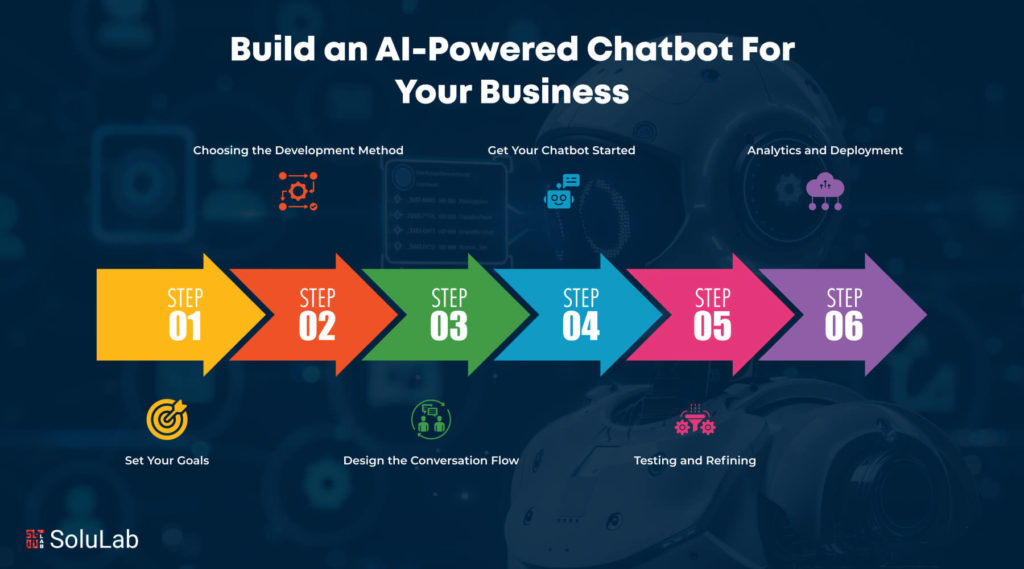
Want to build your artificial intelligence chatbot? They are making waves across education and consumer service. We are going to walk you through the exciting journey of developing a chatbot—from concept to dialog. We will show you how to pick the best resources, design engaging conversations, and even train your AI-powered chatbot to grow and change. Get ready to build informative, entertaining, amazing chatbots!
What are Chatbots?
Have you ever used a virtual assistant or visited some website to ask for help and never really had to talk to a person? Chances are, you are talking with a chatbot. Chatbots are programs designed to mimic human conversation. They range from simple, rule-based applications that provide preset responses to basic questions to complex AI-driven bots.
One of the techniques creating an AI chatbot uses is Natural Language Processing, NLP, which helps them understand all sublimities in human language. This helps chatbots to gauge and assess questions, answer them naturally, and improve with time.
Chatbots are now across the board in messaging apps, websites, and even in phone calls. This is how businesses take orders, answer frequently asked questions, and deal with customer service. AI use cases have applied even in educational settings, giving individualized instruction and answering questions.
What are the Different Types of Chatbots?
We can’t deny the presence of chatbots in our digital lives. Given the many chatbots out there, it is only understandable to be interested in the different types of Chatbots and how they differ from one another. Today, we will consider six well-known chatbot categories:
1. Menu-driven chatbots
Just think of a vending machine that speaks for itself. Well, most of the time, menu-driven chatbots are that. These simple bots present their user with a set of choices in the form of buttons or menus. After the user has selected an option, they receive a hard-coded response, guiding them through some specific function or answering an FAQ. For such basic transactions, like booking an appointment or ordering, they work great.
2. Rule-based Chatbots
They, too, use a predefined set of rules and keywords. While processing the user’s inputs, they look for terms that have pre-written responses related to them. In case the user’s question matches any of the recognized keywords, the chatbot responds with the appropriate response, which can be seen in AI agent use cases Even though menu-driven bots are less flexible compared to complicated ones, they still are incapable of answering complex requests or phrasing known queries differently.
3. AI-Powered Chatbots
Now we enter the age of intelligent dialogue. AI chatbots follow a method of natural language processing to identify the communications made by the user and try to infer what they want to say. The power of AI chatbot can detect synonyms, paraphrase, consider the context of the conversation, and adjust accordingly based on how the user responded previously. All this provides for a better user experience since it allows more organic, human-like dialogues and the perfect example would be chatbots in healthcare.
4. Voice-Activated Chatbots
Imagine talking to your phone or giving voice commands to a virtual assistant. That is what voice-activated chatbots can do. These chatbots allow users to communicate by using their voices through speech recognition technology that converts spoken words to text. They are designed hands-free for applications where typing is a hassle—for example while driving or cooking.
5. Generative AI Chatbots
Embracing the Future! Generative AI chatbots push the boundaries of this technology. The complex bot, in line with machine learning algorithms, generates new formats of text, like scripts or poems, and provides a better understanding of the intent of the user. They even tailor material according to the available information about users, offering a unique and engaging experience.
6. Hybrid Chatbots
The hybrid AI chatbot holds an advantage for both rule-based and AI-driven methodologies. They are capable of handling basic jobs and frequently asked questions with pre-established guidelines and easily escalating complicated queries to AI modules for deeper comprehension. Their adaptiveness enables them to provide a strong, effective conversational experience to a broader spectrum of users.
What is an AI-powered Chatbot?
Imagine a computer program keeping a meaningful dialogue with you, understanding what you intend to do, and even learning new things. That explains what is an AI chatbot. They are not ordinary chatbots but much more advanced compared to their basic relatives. Indeed, to deeply understand human language, they use artificial intelligence, more especially natural language processing.
Enterprise AI Chatbot works with NLP and allows AI chatbots to read your messages, assess the situation, and get what you mean. AI-powered chatbots learn the tone of the message, understand synonyms, and even use experience learned from previous conversations to make their responses more intelligent in the future. This power of chatty ability with a helpful friend becomes a more real flowing one, less like talking to a computer.
AI-powered chatbots have several advantages that enable companies to respond to complex inquiries, provide customer care, and individualize user experiences 24/7. They can replace teachers in the classroom, working according to the needs of students with their very own peculiarities and providing answers with meaning for them. You must build an AI-powered chatbot to make new ways of engaging with technology—from the eased execution of day-to-day activities to having interesting conversations.
How to Build an AI Chatbot?
The area of chatbots is developing in leaps and bounds. It revolutionizes communication in many various industries. Ever felt the urge to create your AI-powered friend? Now you’ll get the breaking of how to create an AI chatbot
Step 1: Set Your Goals
Clearly define what your chatbot is trying to achieve before you start designing your chatbot. What problem is it going to solve? Who is your target audience? Your idea of these will dictate the design and training data. Some examples include the following:
- Customer Service: Answer frequently asked questions, troubleshoot, and direct users to relevant resources.
- Education: Allow Students to go through personalized learning curves, field questions, and provide comments.
- Sales and Marketing: Organize leads, answer product questions, and walk customers through the sales funnel.
Step 2: Choosing the Development Method
The two main paths to consider are:
- Codeless platforms: These are best for beginners and have inbuilt themes, graphical discussion builders, and drag-and-drop interfaces, making them quite user-friendly. This will help support fewer complicated functionalities but reduce technical expertise in return.
- Coding with Frameworks: Microsoft Bot Framework and Rasa are two frameworks that allow additional freedom to a developer while making a customized chatbot. This way gives considerable customization and system integration but requires experience in programming.
Step 3: Design the Conversation Flow
Think about your chatbot as a sort of digital storyteller. Give life to the flowchart in an outline detailing how users will make their way through your bot. Here are a few things you might want to consider:
- You should come up with a friendly, instructive introduction for your chatbot.
- You should consider what kind of questions your bot must be able to answer.
- You should have short and clear responses that answer various user questions.
- Design the conversation to allow consumers to discover its many capabilities and blob around it.
Step 4: Get Your Chatbot Started
This is where the life of your chatbot begins! In this training phase, you feed your bot data that helps it recognize user intent and linguistic patterns. Among the sources are:
- Conversation Scripts: Hand-write exemplar dialogues that illustrate the different user inquiries and intended chatbot replies.
- Chat logs: In case you have already anonymized customer chat data, then this could be a brilliant training tool.
- Public Datasets: There are a lot of publicly available datasets that provide pre-labeled text data to train chatbots.
Step 5: Testing and Refining
Test it a lot. Tweak the responses of your chatbot, understand where it fails, and simulate user interaction. The following are some ways to test:
- Internal Testing: Conduct internal testing within your team to identify technological issues and strange dialogue flows.
- Beta-testing the chatbot with a limited number of outside users will give you input on its efficacy and usability.
Step 6: Analytics and Deployment
Now that you are satisfied with the performance, it is time to bring your HR chatbot into action. Deploy it before your target audience; integrate it with a website, messaging app, or any other platform of your choice. Not to forget, you need to monitor its performance. Track user interactions, identify areas of development, and update your chatbot frequently with new information and features.
Dos and Don’ts While Building a Chatbot
Designing a successful AI chatbot requires careful thought. To help, here is a summary of important dos and don’ts:
Dos:
- Clearly state what you want your chatbot to achieve. What kind of tasks is it able to do? Who is it helping? Avoid developing a chatbot with no clear goal in mind.
- Give users a user-friendly experience. Keep the interactions easy to follow, concise, and clear. Avoid confusing users with complex menus or jargon.
- Do use Natural Language Processing fully to determine the intent of the user and modify the response accordingly. Avoid using simple keyword matching that can often lead to frustrating misunderstandings.
- Be very clear about your chatbot’s constraints. Make sure to tell users where they might need to connect with a human agent. Don’t make the chatbot seem like a super-human in some way. It will only lead to frustration and shattered confidence.
- Test, elicit user feedback, and analyze the data to improve your chatbot further. Avoid letting your chatbot go stale. Keep in touch with the new developments in NLP and the requirements expressed by users.
Don’t’s:
- Avoiding a soul-less, robotic personality. Do give your chatbot a personality fitting your target market or brand.
- Abandon users when they make mistakes or misinterpret. Create mistake-handling systems for unforeseen inquiries and tactful raising of complicated problems.
- Make sure to test well before the release. Have hard internal and external testing to find and fix problems within conversational AI flow and functionality.
- Don’t Build an insular chatbot. To provide a more holistic experience, explore how you can integrate your chatbot with other platforms such as CRM or your knowledge base.
- Don’t Install and forget! Use analytics tools to test, regularly, the performance of your chatbot. View user interaction, highlight areas of improvement, and update your chatbot based on user feedback.
Why Do You Need a Chatbot?
What clients want in this fast-moving world is instant satisfaction. Chatbots are virtual assistants who, 24 hours a day, 7 days a week, respond to inquiries, help fix issues, or simply engage with your audience. But why, in particular, should your business create your own AI chatbot? Here are some compelling reasons:
- Chatbots free human agents from more challenging jobs to be in a position to answer frequently asked questions, resolve common problems, and even set up appointments. Customers will end up being happier because of the quicker response times.
- Since chatbots are always available—unlike human agents who require breaks!—they can ensure that your consumers always have support available by making sure there is reliable support around the clock, including on weekends and holidays.
- Chatbots can gather information from users and modify their responses in line with such information. Imagine a bot able to remember previous purchases a customer made and suggest relevant products.
- Capturing vital client information, chatbots can capture website visitors, answer questions about products, and even qualify the lead for you. This automates your sales process and lets you use your time with high-value prospects.
- Chatbots are cost-effective for customer service compared to other more traditional methods. They can handle large amounts of inquiries, cutting down operational costs and the need for additional staff.
The Final Word
This artificial intelligence bot personalizes user experiences and speeds up customer service for future communication. Building your chatbot is a goal you can reach no matter the level of experience as a developer with available tools and resources and understand the types of Chatbots. As always, the secret is knowing who your audience is, what your objective is, and how to keep improving your work. As you embark on this thrilling adventure, keep in mind the dos and don’ts we have talked about. You can build a chatbot that automates tasks and makes meaningful connections with users if you take serious effort and thought to make it work for them.
Now that you’re ready to jump into the revolution of AI chatbots? It’s your time now to hire an AI developer or AI chatbot development company like SoluLab to experience the difference in technology, the era of powerful and engrossing communication.
FAQs
1. Are chatbots hard to build?
How difficult it would be depends on how you approach the task. No-code platforms’ UI is easy for a beginner to understand, and then again, the code method through frameworks offers more personalization. Programming skills are essential.
2. What are examples of chatbots in live applications?
Chatbots are everywhere! While educational chatbots provide a personalized experience in learning, customer service chatbots answer all your questions on websites. Chatbots are also used extensively in messaging apps for information and entertainment purposes.
3. How can I ensure users get a good experience with my chatbot?
Using NLP, focus on clarity, brevity of speech, and natural interactions in the conversations. Always test thoroughly, elicit user feedback, and constantly refine your chatbot’s responses.
4. What are some limitations of AI chatbots?
Even as Natural Language Processing(NLP) continues improving, chatbots might sometimes miss complex questions or very subtle nuances in language. Be forthright in the admission of your limitations, and always provide a path for more complex issues to be handled by human actors.
5. Can SoluLab help me make a chatbot?
Of course! A team of energetic AI enthusiasts, SoluLab, is here to walk with you in the process of developing a chatbot. SoluLab can collaborate with you on developing a chatbot that will enhance user experience—right from defining your goals to choosing the best platform and establishing captivating conversation flows.






